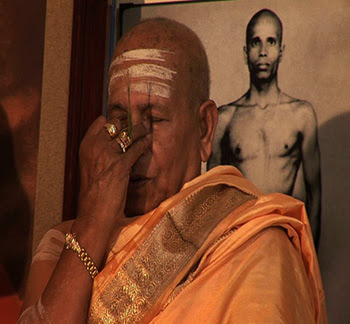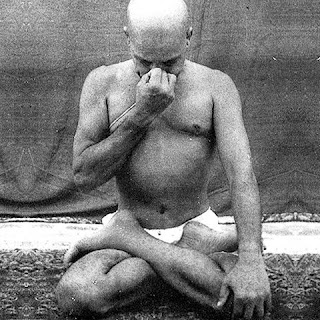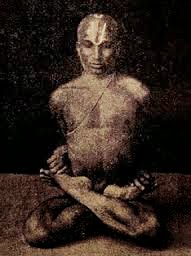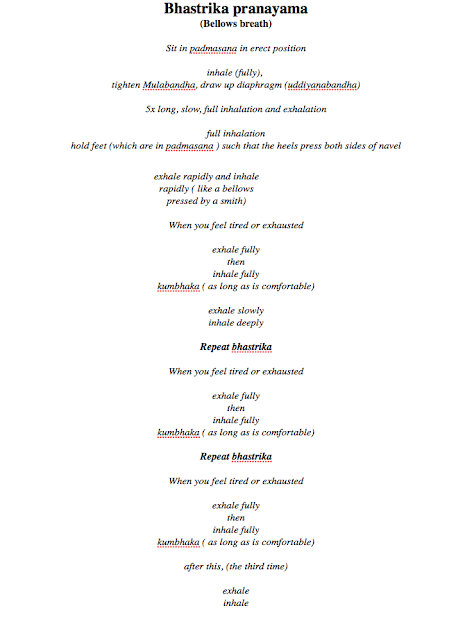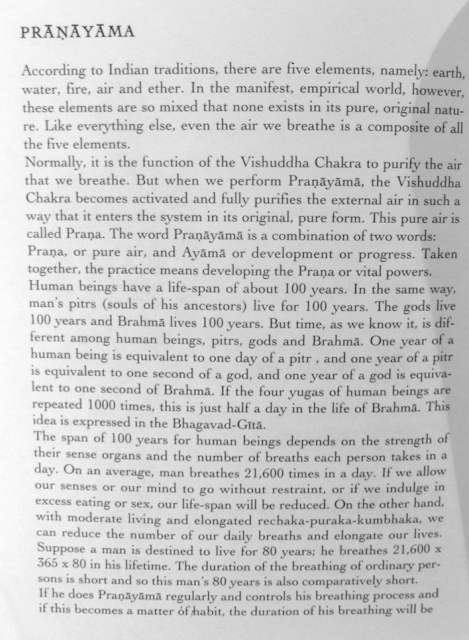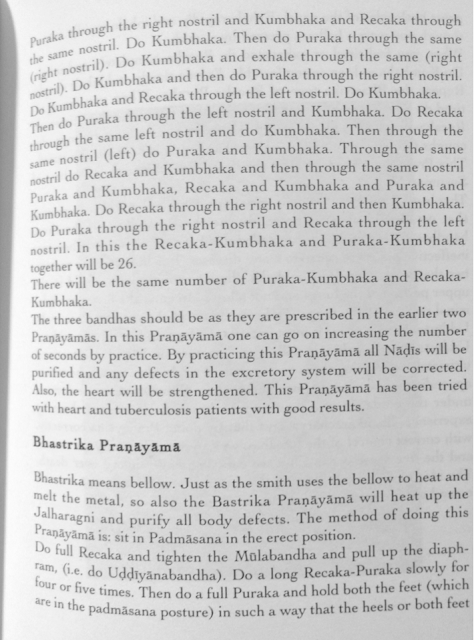"Janu SirsasanaThis form follows the hatha yoga principles. Another form follows the raja yoga method. The practitioner should learn the difference". Krishnamacharya. Yoga Makaranda (1934)This is a very personal post, I'm not making blanket statements or judgements here but perhaps it resonates with others, is there nodding or furious shaking of head (rhetorical question, comments still turned off while traveling).
Context
"
Hatha Yoga comes in for some criticism for its fixation on the physical body. This is truer of modern ãsana yoga than of classical Hatha. The Hatha yogi views the body as a multilayered system of which the physical is only the outer rung, inseparable from inner levels of prána, mind and consciousness. The Hatha yogi is not concerned with the physical in itself but only as a means to access the deeper levels of body and mind. Hatha Yoga is in fact more concerned with prãna than with the body, and looks at the body as a pränic or energy system, not as a mere physiological structure or set of biochemical reactions".
Mikel Burley. Hatha-Yoga Its Context, Theory and Practice
"
....But are the two goals, kaivalya of the raja yogi and the positioning of prana in Brahmarandhra (a chakra) of the hatha yogi, the same? Well, one leads to kaivalya or total release and the snapping of the cycle of samsara, but what of the other? One is not sure if the Hatha yogi's goal will give total release from samsara. What do you think?" p193
Ramaswami. Yoga Beneath the Surface (with David Hurwitz).
*****
"
Hatha Yoga comes in for some criticism for its fixation on the physical body. This is truer of modern ãsana yoga than of classical Hatha".
And what of my Ashtanga practice, is there a fixation on the body here, is it a danger, a temptation, a tendency...... something to watch out for?
I've been thinking of this recently in my asana practice. I'm so aware of my body during practice, of my sensations, sometimes it seems that in any given asana I'm aware of the movement of not only every joint but every sinew, tendon. I have an eye out for any warning signs of pain, "is it safe?" I focus on the breath, how can I breathe more effectively in this posture.... I look to the quality of the breath. I'm aware of the fluctuations of my will. I may not be moved to tears personally in kapotasana but I'm aware of my emotions, how I feel in an asana, the frustrations, anxieties I seek to let go of, the delight I choose to hold on to.
And now in the Shala I'm aware through an adjustments not only my own body but that of another, of the use of their body in their adjustment the weight of the adjustment, the skill, their breath as well as my own, there is a connection between the adjuster and adjusted.
OK, I exaggerate a little, perhaps it used to be like that when I was first working on asana or on new asana, these days I seek to keep my focus on the breath. I have felt though that in the shala I keep coming back to the body, to the asana as Kristina or Niko.... or Manju passes, tidy the asana up a little, and especially so in an adjustment.
Is this all a good thing, are we too much in the body, too much in the senses, is Ashtanga a sensual practice, is a 90-120 asana practice without paranayama and meditation a little much, is it unbalanced.
And after practice, how are we then, do we have a heightened spider-sense, are we more aware of our bodies outside of the shala, of those around us, of our emotions, our senses are we more or less sensual beings outside of the shala.
I remember writing here once how after a Vinyasa Krama practice I felt I walked with my gaze more down, more inward in the sense of less touched by the world around me, withdrawn.... perhaps too withdrawn, while after my Ashtanga practice I would somehow walk taller, shoulders back, head up gaze more outward to the world of experience.
What is the goal of practice, does one practice feed my samskaras another reduce them.
Does one practice, given my personal make up, lead me to be more rajistic another less so.
Does it make sense to say that Ashtanga might make one more rajistic and yet somebody else less so, that Vinyasa Krama could more readily make one person more satvic and yet another perhaps more tamistic (ie. send them to sleep).
I've been thinking of my practice a while back, before I moved the shala to another room. I was practising a form of Vinyasa Krama, Krishnamacharya's own practice as presented by his son Sri. K. Sribhashyam
(see this Link ).
The practice, after an
offering began with a little pranayama, then there would be perhaps 8-12 asana and mudra with a mixture of shorter and longer stays most including a strong mental focal point. The practice tends to include sarvangasana (shoulder stand) and shirsasna (headstand) and end with more pranayama. The practice would take a little over an hour depending on the pranayama, I tended to follow it up with Japa meditation (thinking of presenting this in my last class here tomorrow).
Have been wondering if this practice was/is perhaps better for me.... personally, for my make up, my temperament, my personal samkaras.It will be nice to explore it again in my return to home practice next week.
The video below was an excuse to try out a new Super 8 app for iPhone and some of it's filters recommended by my friend Steve..
I struggle with the word 'spiritual' but I kind of get perhaps what somebody is trying to express when they use the word. Perhaps I'm more comfortable saying that after this practice I felt at my most
satvic. The asana/mudra practice marries well with pranayama and meditation practice, for me at least.
My Vinyasa Krama a little less so but that's perhaps because I tend to include more asana than necessary, I over balance it perhaps.
Ashtanga with it's 90-120 minutes of Asana.... you need a lot of free time in the morning to add another chunk of pranayama and a sit and then your all hot and sweaty on a soaking mat, I am at least. If I end up neglecting my pranayama and meditation practice after my asana practice (saving it for the evening even) then it's perhaps no wonder my practice feels unbalanced, that I'm not feeling that satvic.
No doubt that's why Manju Jois stresses the importance of pranayama and chanting following asana practice, arguing that the practice is incomplete without them.The idea supposedly is that the asana gets rid of the rajas(agitation), the pranayama (lethargy) the tamas leaving you nice and satvic for your sit.
But it might be argued that the practice is supposed to be about the body, that's the hatha aspect that according to hathayogapradipka (HYP) leads to raja yoga.
I'm not convinced by hatha yoga, by HYP, I fns myself nodding when I read that quote from Ramaswami above, here it is again.
"
....But are the two goals, kaivalya of the raja yogi and the positioning of prana in Brahmarandhra (a chakra) of the hatha yogi, the same? Well, one leads to kaivalya or total release and the snapping of the cycle of samsara, but what of the other? One is not sure if the Hatha yogi's goal will give total release from samsara. What do you think?" p193
Ramaswami. Yoga Beneath the Surface (with David Hurwitz).
I'll be presenting a workshop on Krishnamacharya's original Ashtanga and and intro to Vinyasa Krama at Stillpoint yoga, London Bridge on 7th September
http://grimmly2007.blogspot.gr/2014/08/my-workshop-in-london-at-stillpoint.htmlHere's Krishnamacharya on Hatha and Raja yoga, first up AG Mohan who studied with Krishnamacharya in the 70s and 80s followed by references to Hatha and Raja yoga in Krishnamacharya's first book Yoga Makaranda (1934).
*******
Appendix 1
AG Mohan on Krishnamacharya: Hatha and Raja Yoga
"In the West, Krishnamacharya is mostly known for his contribution to the revival of the more physically oriented disciplines and practices of hatha yoga. Therefore, he is often referred to as “the father of modern yoga.”
The notion that Krishnamacharya practiced and taught yoga that was somehow “new” or “modern” is primarily due to the many distortions or misunderstandings about the link between the physical practices of hatha yoga and the meditational practices of raja yoga. He was the conservator of the ancient teachings of raja yoga.
As a master of yoga and a great scholar, he practiced and linked the physical practices of hatha yoga with the mental states of samadhi described in the Yoga Sutras of Patanjali. Let us listen to the great master on what is yoga.
Krishnamacharya:
Yoga is an awareness, a type of knowing. Yoga will end in awareness. Yoga is arresting the fluctuations of the mind as said in the Yoga Sutras (of Patanjali): citta vritti nirodha. When the mind is without any movement, maybe for a quarter of an hour, or even quarter of a minute, you will realize that yoga is of the nature of infinite awareness, infinite knowing. There is no other object there.”During my interview of Krishnamacharya in 1988, he continued to expand on his personal experience of this yogic state of samadhi.
This state of samadhi — the pinnacle of sustained mental focus and the goal of classical yoga — can be reached through pranayama. Krishnamacharya used to say that pranayama is critical among the eight limbs of yoga. The practice of pranayama is preceded by the practice of the mudras and the practice of asanas. "
There is only one yoga, the Yoga Sutras of Patanjali. This is also known as raja yoga. Hatha yoga, laya yoga, and mantra yoga each have four steps. They involve the practice of some of the eight limbs of the Yoga Sutras, like the yamas and niyamas. They merge into the sixth limb of yoga, dharana, which leads to samadhi. Krishnamacharya with his depth of knowledge and practice was clear about these connections.
In the 1930s, Krishnamacharya tried to resolve the prevailing confusions among the then-yoga luminaries. He later recalled:
“In 1933 through 1937, some people were talking about different varieties of yoga, like hatha yoga, raja yoga, and kundalini yoga. Some said that the kriyas were the most important, and that that was (true) yoga. I was in the yoga school in Mysore, under the patronage of the king. I wrote letters to well-known yoga teachers like Paramahamsa Yogananda, Kuvalayananda, and Yogindra, saying that we should have a meeting and resolve such confusion. Eventually, however, no meeting took place and nothing came out of the correspondence.”
AG Mohan Krishnamacharya.net*******
Appendix 2
Hatha and Raja Yoga Mention By Krishnamacharya in Yoga Makaranda There are many types of this yoga — 1. hatha yoga, 2. mantra yoga, 3. laya yoga, 4. raja yoga.
Hatha yogafocusses mainly on descriptions of the methods for doing asanas.
Raja yogateaches the means to improve the skills and talents of the mind through the processes of dharana and dhyana. It also explains how to bring the eleven indriyas under control and stop their activities in the third eye (the eye of wisdom), the ajn ̃a cakra, or the thousand-petalled lotus position (that is turn their attention inward and not outward) and describes how to see the jivatma, the paramatma and all the states of the universe. But even here it is mentioned that to clean the nadis it is necessary to follow the pranayama kramas. p21
Asana11. Janusirsasana (Figure 4.33, 4.34)
This form follows the hatha yoga principles. Another form follows the raja yoga method. The practitioner should learn the difference. First, take either leg and extend it straight out in front. Keep the heel pressed firmly on the floor with the toes pointing upward. That is, the leg should not lean to either side. The base (back) of the knee should be pressed against the ground. Fold the other leg and place the heel against the genitals, with the area above the knee (the thigh) placed straight against the hip. That is, arrange the straight leg which has been extended in front and the folded leg so that together they form an “L”. Up to this point, there is no difference between the practice of the hatha yogi and the raja yogi.
For the hatha yoga practitioner, the heel of the bent leg should be pressed firmly between the rectum and the scrotum. Tightly clasp the extended foot with both hands, raise the head and do puraka kumbhaka. Remain in this position for some time and then, doing recaka, lower the head and place the face onto the knee of the outstretched leg. While doing this, do not pull the breath in. It may be exhaled. After this, raise the head and do puraka. Repeat this on the other side following the rules mentioned above.
The raja yogi should place the back of the sole of the folded leg between the scrotum and the genitals. Now practise following the other rules described above for the hatha yogis. There are 22 vinyasas for janusirsasana. Please note carefully that all parts of the outstretched leg and the folded leg should touch the floor. While holding the feet with the hands, pull and clasp the feet tightly. Keep the head or face or nose on top of the kneecap and remain in this sthiti from 5 minutes up to half an hour. If it is not possible to stay in recaka for that long, raise the head in between, do puraka kumbhaka and then, doing recaka, place the head back down on the knee. While keeping the head lowered onto the knee, puraka kumbhaka should not be done. This rule must be followed in all asanas.
While practising this asana, however much the stomach is pulled in, there will be that much increase in the benefits received. While practising this, after exhaling the breath, hold the breath firmly. Without worrying about why this is so difficult, pull in the stomach beginning with the navel, keep the attention focussed on all the nadis in and near the rectal and the genital areas and pull these upwards — if you do the asana in this way, not only will all urinary diseases, diabetes and such diseases disappear, but wet dreams will stop, the viryam will thicken and the entire body will become strong.
Whoever is unable to pull in the nadis or the stomach may ignore just those instructions and follow the instructions mentioned earlier to the extent possible. Keep the nadis in and near the rectal and genital areas pulled up, the stomach pulled in and hold the prana vayu steady. Anybody with the power to practise this will very soon be free of disease and will get virya balam. Leaving this aside, if you follow the rules according to your capability, you will gradually attain the benefits mentioned below.
Dhauti Kriya's
Several are referred to as either Raja or Hatha yoga p38-51
5. Mulabandha Mudra: With the left heel, firmly press the kandasthana which is between the rectum and the genitals and pull the heel in tightly in order to close the anus. Pull in the stomach firmly and press it against the bones in the back (the spine). Bring in the right heel and place it on top of the genitals. This is in hatha yoga.
7. Mahadeva Mudra: Sit in mula bandha mudra and do kumbhaka in uddiyana bandha.
Benefit: Hunger and thirst subside without loss of body strength and with- out allowing room in the body for any disease. If practised daily, the body develops a lustre in a few days and one quickly reaches the state of samadhi and drinks the divine nectar. This belongs to hatha yoga.
9. Viparita Karani Mudra: Keeping the head on the ground, lift the legs up and hold the entire body straight without bending or curving the body in any direction. This is raja yoga.
11.(a):Vajroli Mudra Form 1: Using both hands, raise the body placing the entire body weight on the hands without allowing the head to touch the ground. Keeping the head this way, hold the body as in viparita karani mudra and do kumbhaka. This is raja yoga.(b) Vajroli Mudra: Form 2: Take a 12 angula long thin glass pipette or lead pipe and through the genital opening insert it and remove it daily, increasing the amount of insertion by one angula each day. After you are able to practise inserting the pipe for a length of twelve angulas, draw in the outside air through such an opening in the genitals. After practising this, eventually draw in milk and then water and then push them out of the body. This is hatha yoga.
15. Sambhavi Mudra: Due to the strength of the traataka abhyasa mentioned in the shatkriyas, after the eyes have teared profusely, fix the gaze on the mid-brow.Benefit: This gives rise to ekagrata citta and gives dhyana siddhi. This is raja yoga.
16. Aswini Mudra: Repeatedly close and open the anal opening many times.Benefit: Cures diseases of the rectum, will render physical strength and sharpness of the intellect, awakens the power of kundalini and conquers untimely death. This is raja yoga.
17. Pasini Mudra: Take the two legs and place them behind the neck. Extend the arms, and with the support of the outstretched hands placed on the ground, raise the body.Benefit: Kundalini being kindled nourishes the body. This is hatha yoga.
18. Kaka Mudra: Hold the mouth like a crow’s beak and inhale and pullin the outside air into the stomach.Benefit: All diseases will be eliminated and you will have a long life like acrow. This is hatha yoga.
19. Mathangini Mudra: Stand in water up to the neck. Through the nostrils, draw in water and spit it out through the mouth. Then take in water through the mouth and expel it out through the nose. This is raja yoga.Benefit: Practise this every day many times in the same place as described above. You will become strong like an elephant, you will not get any diseases and will conquer untimely death.
20. Bhujangini Mudra: Stay in bhujangasana, stretch the neck out in front and according to vata sara krama, pull in the outside air and do puraka kumbhaka.Benefit: This will remove diseases like indigestion, agni mandam (low agni), stop stomach pain and leave you happy. This is raja yoga.
UPDATE
And this from SRi K. Pattabhi Jois' Yoga MalaNotice how for "middle aged he mentions that doing all the asana is a satvic practice, interesting.
But best of all, for me at 51, I get to choose the most useful asana.
"For people over fifty, it is enough to practice some of the easier and more useful asanas, as well as some of the pranayamas. Those who have been practicing for many years, however, can do any asana or pranayama without a problem. Older people who want to start yoga, however, will find practicing the following ten asanas sufficient [see Chapter 2 for detailed descriptions of individual asanas]: first, the Surya Namaskara (types 1 and 2); then Paschimattanasana; Sarvangasana; Halasana; Karnapidasana; Urdhva Padmasana; Pindasana; Matsyasana; Uttana Padasana; and Shirshasana. It is preferable to do these in concert with the vinyasas [breathing and movement systems], but if this is not possible, then practicing while focusing on rechaka and puraka will suffice. Shirshasana should be practiced for at least ten minutes, and the rest, for at least ten rechaka and puraka while in the state of the asana [see fn. 39]. By practicing in this way, the body and sense organs will become firm, the mind purified, longevity will be increased, and the body will be filled with fresh energy.
For the middle-aged, it is best to do all the asanas. The more they are practiced, the stronger the body becomes, and obstacles such as disease cease to be a problem. Pranayama is easier, the mind becomes more harmonious as the quality of sattva [purity] comes to predominate, and intellectual power and longevity are augmented".

















































